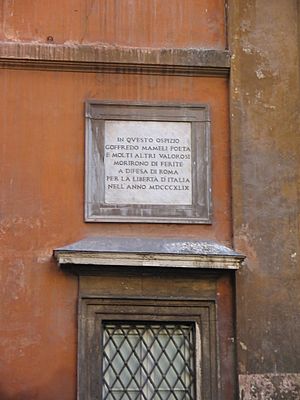Goffredo Mameli facts for kids
Quick facts for kids
Goffredo Mameli
|
|
|---|---|
 |
|
| Born | 5 September 1827 Genoa, Italy
|
| Died | 6 July 1849 (aged 21) Rome, Italy
|
| Resting place | Mausoleo Ossario del Gianicolo, Janiculum, Italy |
| Nationality | Italian |
| Occupation | patriot, poet, and writer |
| Known for | wrote the lyrics of the original version of the Italian national anthem "Il Canto degli Italiani" |
Goffredo Mameli (Italian pronunciation: [ɡofˈfreːdo maˈmɛːli]; 5 September 1827 – 6 July 1849) was an Italian patriot, poet, writer and a notable figure in the Risorgimento. He is also the author of the lyrics of "Il Canto degli Italiani", the national anthem of Italy.
Biography
The son of an aristocratic Sardinian admiral, Mameli was from Genoa where he was born, and where his father was in command of the fleet of the Kingdom of Sardinia. At the age of seven he was sent to Sardinia, to his grandfather's place, to escape the risk of cholera, but soon came back to Genoa to complete his studies.
The achievements of Mameli's very short life are concentrated in only two years, during which time he played major parts in insurrectional movements and the Risorgimento.
In 1847 Mameli joined the Società Entelema, a cultural movement that soon would have turned to a political movement, and here he became interested in the theories of Giuseppe Mazzini.
Mameli is mostly known as the author of the lyrics of the Italian national anthem, Il Canto degli Italiani (music by Michele Novaro), better known in Italy as Inno di Mameli (Mameli's Hymn). These lyrics were used for the first time in November 1847, celebrating King Charles Albert of Sardinia in his visit to Genoa after his first reforms. Mameli's lyrics to a "hymn of the people" —"Suona la tromba"— were set by Giuseppe Verdi the following year.
Mameli was deeply involved in nationalist movements and some more "spectacular" actions are remembered, such as his exposition of the Tricolore (current Italian flag, then prohibited) to celebrate the expulsion of Austrians in 1846. Yet, he was with Nino Bixio (Garibaldi's later major supporter and friend) in a committee for public health, already on a clear Mazzinian position. In March 1848, hearing of the insurrection in Milan, Mameli organised an expedition with 300 other patriots, joined Bixio's troops that were already on site, and entered the town. He was then admitted to Garibaldi's irregular army (really the volunteer brigade of general Torres), as a captain, and met Mazzini.
Back in Genoa, he worked more on a literary side, wrote several hymns and other compositions, he became the director of the newspaper Diario del Popolo ("People's Daily"), and promoted a press campaign for a war against Austria. In December 1848 Mameli reached Rome, where Pellegrino Rossi had been murdered, helping in the clandestine works for declaration (9 February 1849) of the Roman Republic. Mameli then went to Florence where he proposed the creation of a common state between Tuscany and Latium.
In April 1849 he was again in Genoa, with Bixio, where a popular insurrection was strongly opposed by General Alberto La Marmora. Mameli soon left again for Rome, where the French had come to support the Papacy (Pope Pius IX had actually escaped from the town) and took active part in the combat.
Death
During the siege of Rome, he was an aide of Giuseppe Garibaldi, who fought in Palestrina (9 May) and in Velletri (19 May). In particular he fought in the defense of the Villa del Vascello on the Janiculum hill. He was wounded in the left leg by the French during the last assault of 3 June at Villa Corsini, occupied by the French. However, there is a theory that he was accidentally wounded by the bayonet of a fellow soldier.
Mameli suffered from gangrene, which doctor Pietro Maestri observed after four days. After a consultation with Maestri and other doctors, it was decided to amputate the leg, performed by surgeon Paolo Maria Raffaello Baroni. Despite this, the infection gradually increased to the point of causing death by sepsis, on 6 July 1849, at the age of 21, in the hospice of Trinità dei Pellegrini. He was originally buried at Campo Verano in Rome, however, his remains were moved to the Mausoleo Ossario del Gianicolo in 1941.
See also
 In Spanish: Goffredo Mameli para niños
In Spanish: Goffredo Mameli para niños



